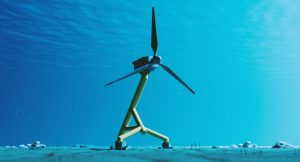
The tidal energy sector has enormous potential to help balance the energy grids and achieve a just transition to net zero. Seventy per cent of the earth’s surface is ocean and seas and, if we could harness that energy, it would provide 150 per cent of the world’s power needs.
A recent report found that tidal stream energy could provide more than 6GW of energy to the UK grid by 2050. While this is modest compared to the potential of offshore wind, the predictability of tidal energy in contrast to the seasonal fluctuations of wave, solar and wind means that it offers a reliable baseline power source for our future electricity needs.
Challenge
Harvesting tidal energy has proven difficult and expensive, particularly from an engineering standpoint. The sea is a harsh environment – corrosive, difficult and expensive to access, and often dangerous. One of the main technical challenges is the large load fluctuations that are experienced by the blades, which can result in blade fatigue failures and power fluctuations at the generator.
To optimise energy generation and reduce the need for costly repairs, it’s important to address unsteady load mitigation and minimise downtime while adding minimal complexity to the turbine. An EPSRC-funded collaboration between Professor of Fluid Mechanics and Bioinspired Engineering Ignazio Maria Viola and Senior Lecturer in Composites Design and Testing Dr Eddie McCarthy has thus far resulted in two novel technologies that promise to reduce unsteady loading, decrease the levelized cost of energy and improve turbine resilience and reliability.
Flexible tech in more ways than one
The two technologies developed by Viola and McCarthy allow for the passive morph of the blade, with each promising to increase energy yield and decrease capital and operational costs. The first technology is a morphing blade with a flexible trailing edge that deforms in response to changes in the fluid load; the second is a passive pitching mechanism for conventional rigid blades that allows the blades to pitch in response to varying loads independently. Both technologies have the potential to reduce the levelized cost of energy production, and as a further boost for the project’s green credentials, the pitching mechanism can be retrofitted to existing turbines for greater durability, which reduces wastage and the need for new materials.
Dr Eddie McCarthy said:
Both of these passive pitching technologies are aimed at effectively mitigating severe load surges during operation. The passive approach minimises the level of active control required, can greatly simplify the turbine control system, and thus assist in reducing operational risk and decreasing levelized cost of energy of tidal stream technology.”
Dr Angus Stewart-Liddon, Senior Technology Transfer Manager at EI, said:
Successful transition to net zero is multifaceted, and an important element is going to be innovations that enable renewable energy systems to maximise their impact. Researchers at the University of Edinburgh are rising to this challenge, and it’s exciting to see these two new technologies emerge which can offer commercial value for industry partners.”
Not only can these technologies help realise the potential of tidal energy as a key player in the field of renewables, they can also be applied to other turbines systems, such as wind. Patent applications on each technology has been filed with the support of Edinburgh Innovations’ Technology Transfer team, and are available for commercial development and licensing.